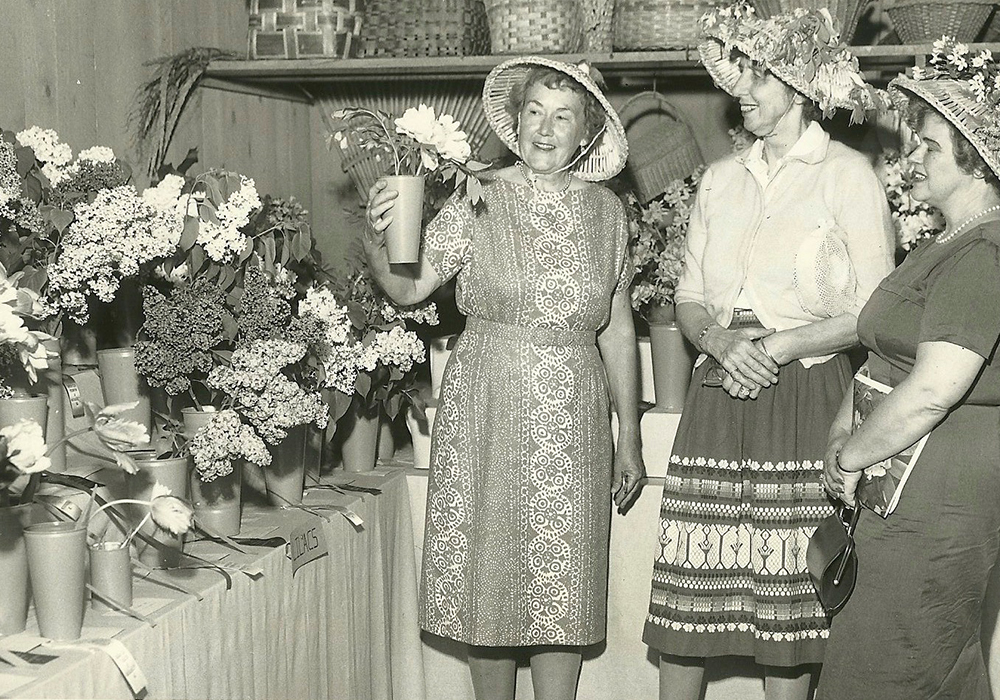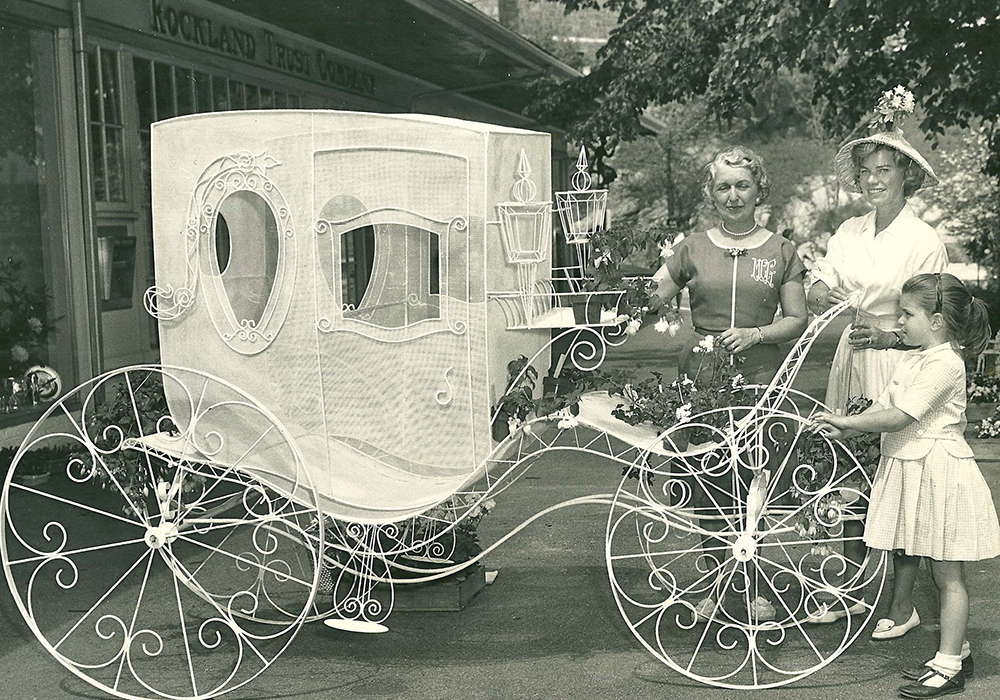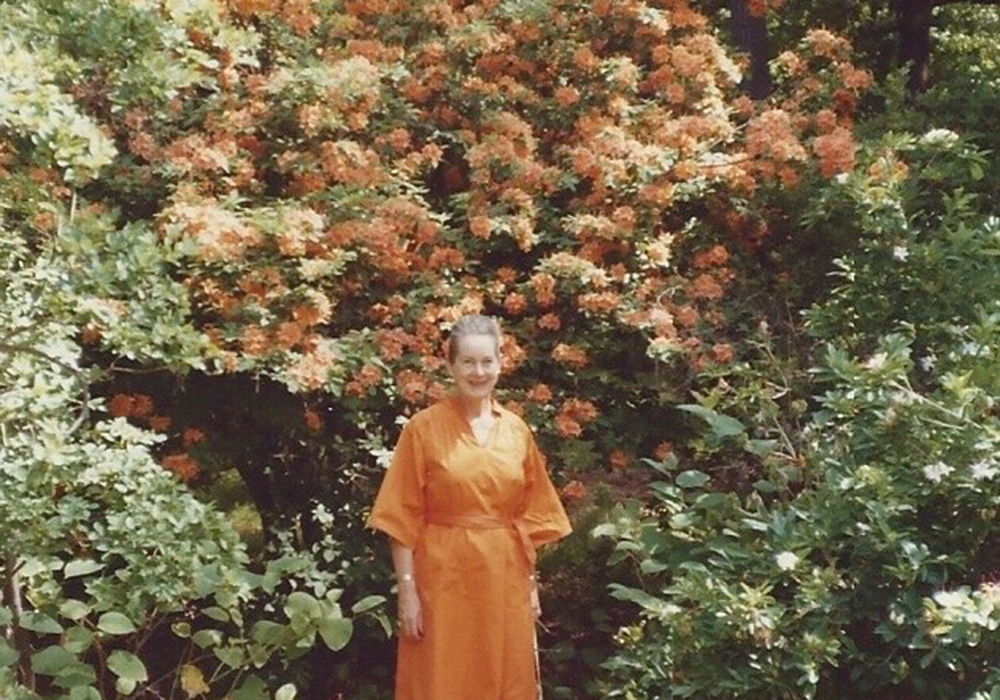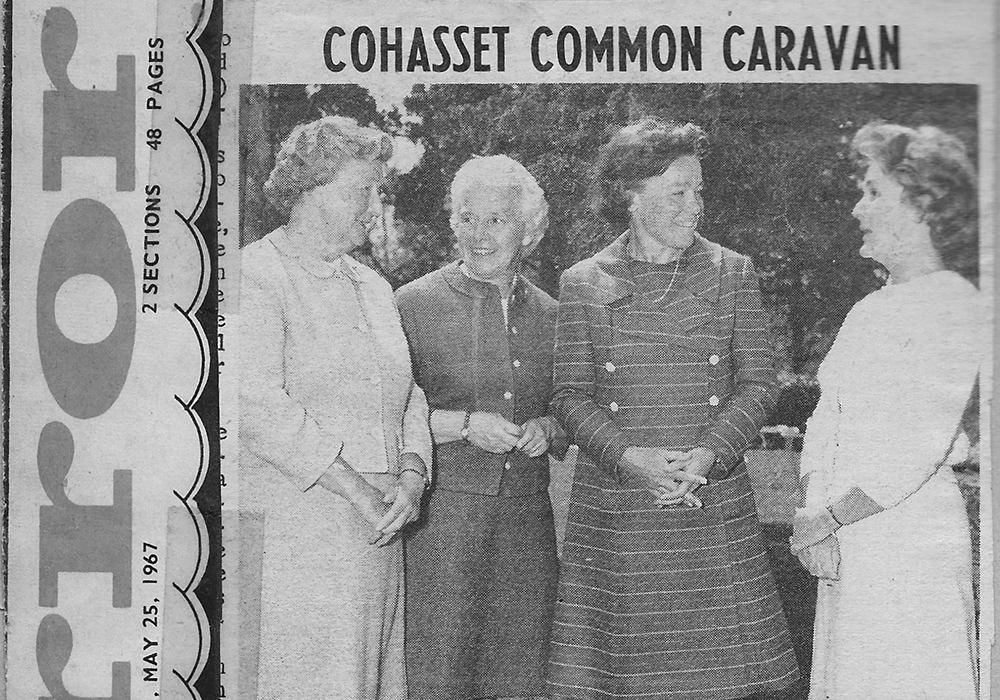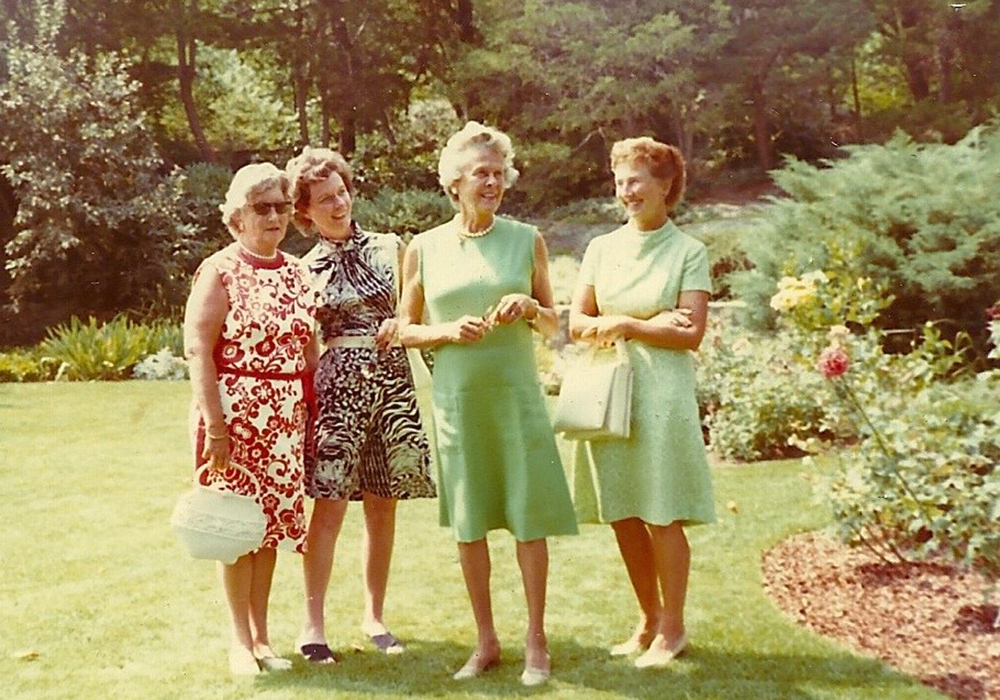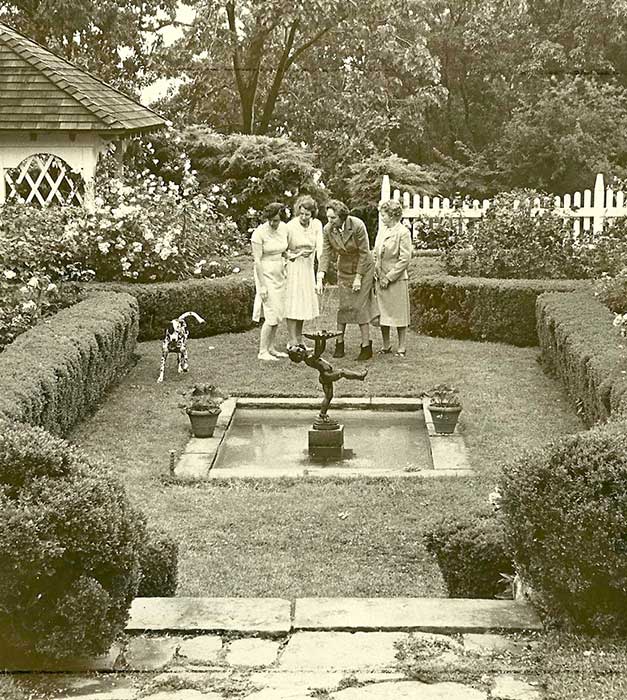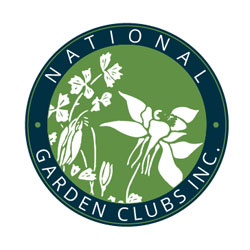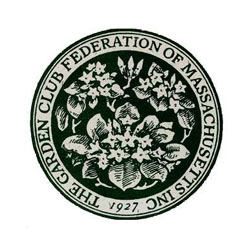Our History
After World War I, with the United States securely established as a player on the world stage, American women found their horizons significantly expanded. They had gained the vote, and rising prosperity presented more women than ever before in history with the means and leisure to move beyond the domestic. By the end of the century they would be closer to equality with men. At this point, in the 1920s, ambitious women turned their talents to the manageable options open to them: helping alleviate the tribulations of poor women and children, preserving open land and the remnants of the great forests, establishing parks for the benefit of all, and expanding educational opportunity for children. Many women with time at their disposal turned to gardening, reflecting Kipling’s thought that:
Some can pot begonias
And some can bud a rose
And some are hardly fit to trust with anything that grows.
But they can weed and trim the lawns
And sift the sand and loam
For the glory of the garden glorifieth everyone
Before the post-war period, gardening meant different things to different folk. For most, it meant cultivating back yard plots to put food on families’ tables, while for centuries people in many societies had viewed gardening as both an art form and subject for scientific inquiry into horticulture. The late nineteenth century had seen the enthusiastic establishment of formal associations for those sharing common interests. Antiquarians and epicureans, hunters and golfers set up clubs with stated goals, bylaws, and selected membership. Gardeners were following a popular trend when they organized their own societies.
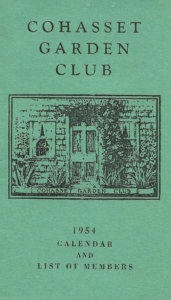
The First Club
In 1924, a small group of Cohasset women started an informal garden club with Mrs. B.Preston Clark as their leader. Members of the original group included Mrs. J. Franklin McElwain, Mrs. Eugene F. Ladd, Miss Mary C. Sears, Mrs. Charles C. Wheelwright, and Mrs. J. Willard Tuckerman. Not until 1925 was an organized club established with Mrs. Eugene F. Ladd as president. The first elected officers were Mrs. Alanson Bigelow, Mrs. Delano Wight, Mrs. Charles F. Cutler, and Mrs. William H. Brown. The Club constitution defined their objectives: “To stimulate the knowledge and love of gardening among amateurs; to share the advantages of association through conference and correspondence in this community, country, and abroad to aid in the protection of native plants and birds; and to encourage civic planting.”
Two years later, in 1927, the Cohasset Garden Club, proposed by the North Shore Garden Club and seconded by the Chestnut Hill Garden Club, was elected to the Garden Club ofAmerica (GCA). Records note that “many other clubs of higher standing had failed to meet the high standards of this national organization.” Affiliation with GCA offered wider horizons to Club members, but also imposed restrictions on membership numbers and allocation of dues. These restrictions have since been updated and allowed the club to become what it is today—a vibrant contributing member to our Cohasset Community.
2006-2020
The world is startlingly different from what it was when the Cohasset Garden Club began in 1925, but the joy and comfort of gardening endures, even while a pandemic, eerily similar to the one a century ago, has kept us apart for an entire year. As a lovingly-tended garden grows, so do our activities and our efforts to spread the joy to more people in our community and beyond. We have become more conscious of and involved in conservation; we have taken on new civic projects; we have embraced photography and botanical arts as ways to celebrate the glory of nature; and we are exploring how the digital world can enhance our knowledge of gardening and our ability to work together.
Many of the things we have done each year for decades remain constant, because they are valuable, fascinating and fun. We meet monthly from March to October to conduct regular business and listen to terrific speakers on everything from Adelaide Pratt’s photography to weeds, wasps and worms. At several of the meetings, we exhibit floral designs, horticulture from our gardens and photographs, and we invite the public to enjoy them. We concoct workshops to learn new skills, like plant propagation, Ikebana and Indian block printing. We come together in teams to maintain civic gardens and send a duo to the MFA to create an arrangement for Art in Bloom. Reaching out, we support local, regional and national gardening and conservation organizations like Holly Hill Farm, the New England Wildflower Society and, of course, the GCA, with both funding and hands-on help. In addition to working on Zone meetings and committees, we send delegates to the annual NAL conference and the beloved Shirley Meneice Horticultural Conference. To make all this possible, we fund our efforts with delightful parties in members’ homes, with the goodies provided by our creative cooks and auction items donated by everyone.
In this section of the Club’s history, we highlight innovations, expanded horizons, regional and national awards (too many well-deserved club awards to list here) and milestones reached, year by year. This should make the narrative easier to amend as we add new members, new ideas and new chapters to a long and colorful story of women committed to making our world a more harmonious and beautiful place.
2006
The workshop re-energization begun in 2005 continued, enticing more members to become involved. Imaginative offerings included “Saturday pruning…followed by Bloody Marys” and a multi-session course in creating floral designs according to the Sogetsu School of Ikebana.
There was a concerted effort to promote more interest in conservation, with global warming as a focus. Each member took the BP Carbon Footprint test, with the result that the club average was 20% lower than the national average. Three of our programs centered on protecting our environment, one being a kayak trip to explore areas accessible only at high tide.
Ways and Means put on a fabulous Derby Day party at Pat Michaud’s house, producing a great deal of fun and a tidy income. We did a repeat Derby Day at Pat’s in 2011 and raised even more for the club.
Beyond our club, Sarah Pease served as the Zone 1 Scholarship Representative (2005-7), and Jane Goedecke took on the giant responsibility of co-chairing the GCA Annual Meeting held in Boston in 2007. Club members pitched in to help make it memorable.
2007
After major repairs to the Captain John Wilson House and the Maritime Museum, Margaret Cotter and Mary Hartshorne worked with the Historical Society to design a historically accurate garden with appropriate plants for the period and our seaside environment. The revitalized Virginia Knowles garden was installed and a professional was hired to clear the ledge behind of overgrown vines and refuse that filled 15 dump trucks. The Memorial Fund paid for the project as a gift from the club to the town.
Marguerite Borden’s gardens at “Unicorn Cottage” were documented by Margaret Cotter and accepted into the Smithsonian Archives of American Gardens.
The fall “Jack-O-Lantern” fundraiser featured cocktails, an auction and a pumpkin carving contest, with the entries glowing merrily on Jane Goedecke’s front porch.
On the national and regional levels, our members shined: Jane Goedecke was appointed GCA Chairman of the Policy Research Committee and GCA Parliamentarian, and Sarah Pease became a GCA Scholarship Committee Vice-Chair, continuing for several different scholarships until 2013. Marguerite Borden took over as Zone 1 Scholarship Rep, and Patsy Rabstejnek became Zone 1 Visiting Gardens Rep.
2008
This year brought broader recognition of our club talents. Two members won GCA Zone 1 awards: Anne Elwell Reardon for Flower Arrangement Achievement and Jane Goedecke for Creative Leadership.
We began experimenting with different meeting times and styles, more attractive and convenient for our younger members. Wine and cheese, an afternoon hike and live owls all were part of the part of this year’s program.
Taking a cue from the objectives of the club’s founders, we “stimulated the knowledge and love of gardening… and shared the advantages of association” with an informal Open Gardens Day, where several members invited the club and their guests to their gardens to enjoy the beauty and swap ideas.
2009
More Zone 1 kudos, this time to Pat Michaud, who won the Nell Schwartz Mentoring award for her ability to do almost everything well and share her experience with others. Jon Belber of Holly Hill Farm won a GCA Elizabeth Abernathy Hull Award for providing outstanding education for our youth.
Our growing interest in preparing for climate change was reflected in programs on global warming and sustainable landscaping. We teamed with the Gulf River Association to invite Marie Stella, a noted landscape designer and historian, who told us about “Gardening for the 21st Century.
Marguerite Borden was elevated to Zone 1 Vice-Chair, and Jane Goedecke became Zone 1 Nominating Committee Rep.
2010
Two members’ gardens, Genevra Higginson’s Cedar Ledges and Patsy Rabstejnek’s Ravenstone were accepted into the Smithsonian Archives of American Gardens thanks to two years of research, documentation and photography by Martha Gangemi, Laura McAuliffe and Anna Sandell.
Sandy Durant spearheaded the production of the Green Resource Guide, which lists organic farms, “green” options for cleaning, building, lawn and pet products and much more, available locally and online. She also oversaw our community meeting, where Paul Tukey spoke on “Safe Lawns,” in conjunction with the Gulf River Association.
Susan Kearney was honored with the Zone 1 Creative Leadership award, and Jane Goedecke was appointed GCA Nominating Committee Chair.
2011
Our four “golden girls,” Eleanor Bleakie, Genevieve Good, Genevra Higginson and Alison Jordan each received an award for 50+ years of GCA membership. It was a celebration of extraordinary accomplishment and dedicated service.
On the Garden History and Design front, Ginger King’s garden, Kingsview, was officially accepted into the Smithsonian Archives. In preparation for the 2013 Zone 1 meeting in Cohasset, our “3M” team – Margaret Cotter, Mary Hartshorne and Martha Gangemi – planned a renovation of our club’s section of the Lightkeeper’s Cottage garden.
For the first time, our club held a monthly meeting at GCA Headquarters in New York. The group traveled south by train the day before, enjoyed an April day in the city, and toured the collection of rare books and botanical art owned by the GCA. The consensus was that this trip would be a treat to repeat.
National and regional leadership continued, with Marguerite Borden elected as Zone 1 Director and Jane Goedecke appointed to chair the GCA Awards Committee. Patsy Rabstejnek assumed the position of Zone 1 Awards Rep.
2012
This year was the beginning of a fruitful tradition, as the Conservation Committee elected to participate in the North American Pollinator Protection Campaign (NAPPC). Our proposal to the Osgood School for a children’s pollinator education program was accepted and set for launch in spring 2013.
The Boston Committee, with Pat Michaud as our representative, chose to award $50,000 to the Harbor-Link Gardens of the Rose Kennedy Greenway, installing planters on the walkway over the Northern Avenue Bridge.
The White Party at Eleanor Bleakie’s home was a brilliant success, full of fun and funds to support our club.
2013
Cohasset Garden Club hosted the Zone 1 annual meeting, ably chaired by Jane Reardon and Debbie Shadd and held in Hull with a fantastic view of the ocean. The horticulture competition was led by Zone Hort Chair Anne Elwell Reardon, and our club won the most blue ribbons to capture the Corliss Knapp Engle Sweepstakes Award. Our civic garden teams spiffed up all the gardens to delight our Zone 1 visitors.
Photography came into its own, as Laura McAuliffe, our photo pioneer and winner of the 2012 GCA Novice Photography Award, joined the board. Laura and Barbara Wallner acquired display boards, set up the Zone show, and put on our first club show that drew 26 participants.
“Bee a Pollinator Pal” Week premiered at Osgood school to the delight of the second graders and the whole community. Our club provided the garden, the artwork to color, the naturalist speaker, the pollination video, the dress-up day, the planting instruction and best of all, the butterfly release. Students went home with marigold seeds from Holly Hill Farm to plant in their own gardens. The Conservation Committee, especially Sandy Durant and Vanessa Day (Osgood’s Curriculum Enrichment Coordinator) planned it all perfectly. It was one for the ages, and the first of many in the coming years.
Awards came pouring in: Holly Hill Farm won a Zone 1 Conservation Commendation for their preservation of the historic landscape and structures, sustainable farming and community education. Susan Kearney earned the Kitty Ferguson Award for her commitment to GCA goals and generosity of spirit. Our “Let There Bee Light” exhibit highlighting the Pollinator Pal program captured the Marion Thompson Fuller Brown Conservation Award at the Zone 1 show.
Meanwhile, Marguerite Borden served as our Zone 1 Nominating Committee Rep and moved up to chair the GCA Nominating Committee for the next year. Ginger King, known for her fabulous horticulture, became a GCA Hort judge and is a candidate in Floral Design.
2014
A crew of board members banded together in early spring to identify, photograph and move many of the plants in a Smithsonian-documented garden documented that were to be lost to new construction. Over course of several days, they were relocated to new homes in the Lightkeeper’s and Knowles gardens.
Pat Michaud’s Seaside Gardens were documented by the Garden History and Design Committee and accepted into the Smithsonian Archives.
The Club Historian, Debbie Shadd, and her committee created an oral history of Cohasset Garden Club by interviewing and videotaping four long-term members, Eleanor Bleakie, Genevieve Good, Patsy Leggat and Mary Hartshorne. They reminisced for almost two hours about the club and the town, and the video was professionally edited and made available as a DVD. Also this year, Lucia Woods achieved 50 years of GCA membership, joining the “golden girls” of 2011.
2015
More prizes: Marguerite Borden won the Kitty Ferguson Award for dedication to the goals of the GCA and Zone 1. The new Lucia R. Woods bowl for photography was inaugurated, cementing our commitment to revealing and sharing the beauty around us. And Patsy Leggat marked 50 years of GCA membership, our sixth half-century achiever in the past five years.
Following a winter with record-breaking snowfall (108.6 inches), the civic gardens we maintain, including the Osgood pollinator-friendly plot, had a great spring, summer and fall. Transplants flourished and a new cherry tree was planted between the historic houses in the village.
We tried combining the design, horticulture and photography shows twice, which worked because they were held at the St. Anthony’s Parish Hall, with lots of space. This explosion of riches continued with at least one joint show in the following years.
Zone 1 again benefitted from our leadership as Bet Baker began her term as Zone Vice-Chair and Debbie Shadd served as Zone representative for Conservation and NAL.
2016
We said goodbye to two of our extraordinary long-term members, Genevieve Good and Lucia Woods, who lived to 100 and 94 respectively. It looks like gardening, which is good for the soul, is also linked to longevity. A new club award was instituted in honor of Genevieve, for a member of less than seven years who has exhibited commitment to the Club above and beyond expectations.
A significant part of the Lightkeeper’s garden was replanted with help from Benji Watson. We used our pruning tools to discipline overgrown plantings and added hydrangeas, junipers, cypress and boxwoods.
A few small, but significant innovations: a dive into digital photography with two workshops at the Derby Street Apple store, and the design of a CGC website by Sandy Durant and Barbara Wallner. Less technical but widely welcomed, we began to provide a light lunch of savory snacks before our monthly meetings.
The multi-talented Pat Michaud received the Zone 1 Judges Award, and Marguerite Borden was elected a VP on the GCA Executive Board for a two-year term.
2017
It was a banner year for community outreach and support. As part of the GCA’s 2013 Centennial Tree Project, we had reserved funds for new tree planting. When we were approached by citizens concerned about the loss of trees on the Cohasset Common, we stepped up. The project, led by Debbie Shadd, Susan Pile and our landscape designer Margaret Cotter, the project included the installation of five new trees – three autumn cherries, one tulip tree and one red maple. We also supported the Trustees (of Reservations) and their World’s End Rejuvenation Project by contributing $5000 for landscape restoration, perhaps our largest single donation to another organization that supports our mission. Of course, we maintained our annual memberships in ten other organizations that we have long supported.
It also was a year of expansion and renewal for our civic gardens. At the Lightkeeper’s Cottage, we increased our area down the hill to the shed, using plants donated by a Cohasset resident. At the Wilson House and the Maritime Museum, we planted new shrubs and hired a local arborist to prune and cut back trees and shrubs on the rocks behind the structures.
We had fun, too, notably at an evening meeting in the Davis’s barn with invited guests and a buffet supper. Our speaker was Neal Sanders, author of 15 mysteries, many set among garden clubs, with strong, independent women protagonists. His theme for the evening was gardening while married: with his wife as the brain and him as the brawn. He had us howling with laughter and left us hungry for more speakers like this.
In a year of firsts, we instituted the “Pop-Up Garden Visit,” suggested by Jan Todd. Members with something particularly lovely in their gardens at the moment invited the club to drop by anytime to see it. Four years later, the tradition endures.
Our own Bet Baker became Zone 1 Chairman, and Martha Gangemi began her term as Zone Photography Rep. Marguerite Borden won the Zone Creative Leadership Award!
2018
In 2018, the Cohasset Garden Club website finally bloomed, thanks to tireless tending by Sandy Durant and Barbara Wallner. The site debuts a new logo that was easier to discern than the old cottage door; it’s a hummingbird hovering over a flower, chosen by a vote of the membership. The public pages highlight our mission (including pollinator protection), civic projects, outreach, public meetings and flower shows and the local Smithsonian Archives gardens. The member pages include announcements, our calendar, contact lists and sections on each of our activities. All the pages are decked with gorgeous photos.
The annual Pollinator Week at Osgood School continued to delight second-graders. After “planting” an earthworm, one child remarked, “So this is what worms are for!” The GCA recognized the program as one of six innovative projects for children and featured it at their quarterly business meeting.
Our annual fundraisers get more creative as the years pass. Everything was “In the Pink” at the Davis’s, from the cocktails to the wrapping covering the bottles on the “wine wall.” Everyone donated at least one wine and took home at least one mystery bottle. A glorious paella was the centerpiece for the meal, thanks to the generosity of two husbands.
2019
Botanical Arts came into its own as part of our flower shows, thanks largely to member Sarah Boynton, a well-known BA award-winner and our patient instructor.
The GCA Annual Meeting in May was hosted by Zone 1, and we did our part by organizing a seaside garden tour of the Rabstejnek, Vanderweil and Todd gardens with our club members as guides. The day started with a torrent of rain, but it cleared in time for everyone to tiptoe through the lush landscapes.
Thanks to Margaret Cotter’s hard work in proposing Holly Hill Farm to the Smithsonian as a garden resource, the Garden History and Design team focused on documentation in maps and photographs for submittal in 2020.
A brand-new idea in 2019, “Random Acts of Flowers” instituted pop-up deliveries of arrangements to club members in need of a boost. These lovely surprises to be continued…
Marguerite Borden was appointed GCA Policy Research Committee Chair and GCA Parliamentarian, while Bet Baker became Zone 1 Nominating Committee Rep and was chosen to become GCA Nominating Committee Chair starting in 2020. That made THREE members of our club who served as Nominating Committee Chair!
2020
After only one monthly meeting, our club went virtual, courtesy of Covid-19. While many things had to be cancelled, even Pollinator Week, we found a few silver linings. For the first time, anyone could attend the iconic Shirley Meneice Conference, NAL and sessions of the GCA annual meeting. And as our president, Lisa Fulton, said, “Our gardens have never looked better.”
In the spring, Vanessa Day’s daughter collected photos of members’ gardens in bud and in bloom, compiling them into an awesome slideshow set to music for all to share.
In May, eleven fearless members, led by Provisional Lisey Good, worked at least six feet apart at Holly Hill Farm, harvesting 24 large feed bags of invasive garlic mustard.
We had our first virtual photography competitions, where the votes came not from judges, but from members. Participation doubled from last year, and the results were presented to us on Zoom. At our annual meeting in the fall – also on Zoom – we were thrilled by a panoply of flower arrangements created by the Design Committee.

